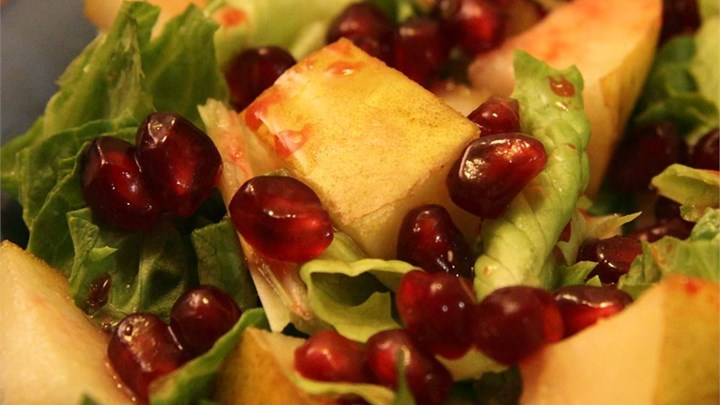Ruby Red Pomegranates - Unique and Nutritious
TEXARKANA, Ark. –
In the grocery store aisle you may see a fruit about the size of an apple, with a brilliant ruby red exterior. It may seem an odd fruit, with its leathery appearance, and apple-like size. But what is it and what do you do with it? Do you eat it; if so how? Do you decorate with it? Do you just admire it for its brilliant color and shape?
I am talking about the pomegranate, thought to have originated in the Persia and Sub-Himalayan foothills of Northern India. It now is produced at a commercial scale in the Mediterranean regions.
This fruit is so unique in that instead of eating the bitter, spongy, white membrane inside the pomegranate, it is the tiny seeds – called arils – inside which are eaten. Each aril is a delicious sac of juice that surrounds an edible seed. The arils range in colors from pink to dark red.
Pomegranates are not only delicious and beautiful, they are also nutritious. They are considered to be high in vitamin C and potassium, a good source of dietary fiber, which aids in smooth digestion and bowel movements, and are low in calories. In fact, one half cup of arils is about 80 calories, but contain 5 grams of fiber. The fruit is also a good source of vitamin-C, which helps the body develop resistance against infectious agents by boosting immunity. Researchers found that regular consumption of pomegranate to be effective against prostate cancer, diabetes, and lymphoma.
To choose ripe pomegranates, look for a well-developed, firm, bright crimson red fruit, that feels heavy for its size. The heavier it feels, the juicier it will be. Avoid spotted, over-mature fruits as they can be bitter and inedible. Avoid those with surface cracks, mold, and fruit that is bruised or shriveled as they are inferior in flavor. Once home, store them in a cool dark place at room temperature for 5-8 days or more. In general, pomegranates possess a long shelf life. You can also put them in the refrigerator for a couple of weeks.
Follow the three step method to retrieving the arils. First, cut off the “crown,” then score the outer layer of the skin into sections. Second, place the pomegranate in a large bowl of water and break apart the sections along the score lines. Roll out the arils with your fingers. The arils will sink to the bottom while the white membrane floats to the top. Third, strain out the water. The arils are ready to eat and to enjoy their juicy goodness. You can purchase the arils without the shell but the cost is pricey.
Fresh arils placed in an airtight container will keep for a few days in the refrigerator. If you choose to freeze them, freeze in single layers on trays; then package in an airtight container for up to 6 months. Remove only the arils that you plan to use at the time.
There are many uses for the Pomegranate arils. They make an attractive garnish on salads and dishes; can be made into juice for drinking or to use later in preparing soups, jellies, sorbets, sauces as well as to flavor cakes, baked apples, and other desserts. Pomegranate concentrate is a popular ingredient used in Middle Eastern and Mediterranean recipes.
Add pomegranate to your grocery list to purchase next time you shop and add it to your fruit bowl. It will not only add color, it will be a delightful nutritious treat.
For more information, contact the Miller County Extension Office, 870-779-3609 or visit us in room 215 at the Miller County Courthouse. We're online at chadley@uada.edu, on Facebook at UAEXMillerCountyFCS/CarlaHaleyHadley, on Twitter @MillerCountyFCS or on the web at uaex.uada.edu/Miller
Experiment with pomegranates in this Pear and Pomegranate Salad with Warm Dressing. The combination of the sweet pear and tart pomegranate seeds work nicely together adding color, crunch, and flavor.
Pear and Pomegranate Salad with Warm Dressing
6 cups romaine lettuce, rinsed and torn
2 Bartlett or Anjou pears
2/3 cups pomegranate seeds
2 tablespoons olive oil
1/4 cup pomegranate juice
2 tablespoons lemon juice
2 teaspoons prepared Dijon-style mustard
1 tablespoon honey
ground black pepper to taste
Add rinsed and torn lettuce to serving bowl. Halve, core and dice the pears. Add pears and pomegranate seeds to the bowl and toss lightly.
Combine the olive oil, pomegranate juice, lemon juice, mustard, honey, and pepper in a saucepan. Bring to a boil over high heat; reduce heat and simmer, stirring frequently, until the dressing thickens slightly, about 2 minutes. Pour the warm dressing over the salad and serve immediately.
By Carla Haley-Hadley
County Extension Agent - FCS
The Cooperative Extension Service
U of A System Division of Agriculture
Media Contact: Carla Haley-Hadley
County Extension Agent - FCS
U of A Division of Agriculture
Cooperative Extension Service
400 Laurel Street, Suite 215 Texarkana AR 71854
(870) 779-3609
chadley@uada.edu
The Arkansas Cooperative Extension Service is an equal opportunity institution. If
you require a reasonable accommodation to participate or need materials in another
format, please contact your County Extension office (or other appropriate office)
as soon as possible. Dial 711 for Arkansas Relay.
Pursuant to 7 CFR § 15.3, the University of Arkansas System Division of Agriculture
offers all its Extension and Research programs and services (including employment)
without regard to race, color, sex, national origin, religion, age, disability, marital
or veteran status, genetic information, sexual preference, pregnancy or any other
legally protected status, and is an equal opportunity institution.
